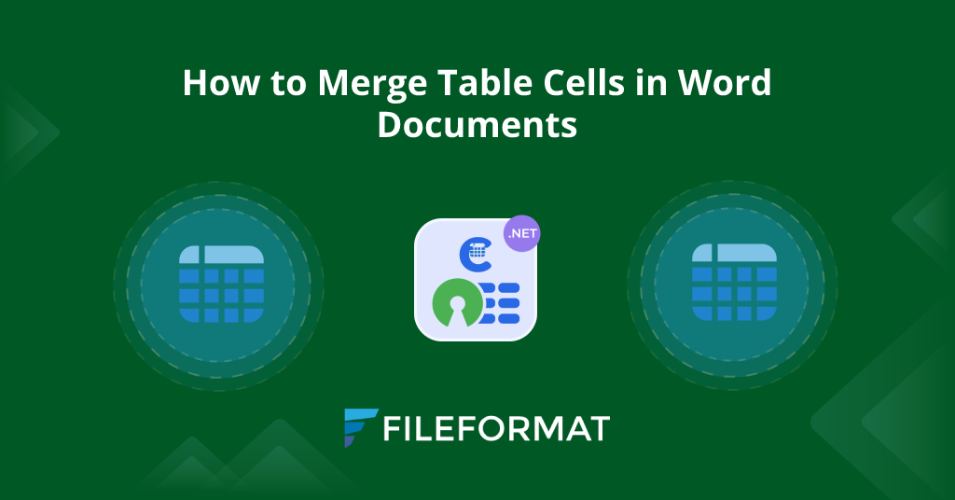在DOC/DOCX文件中执行一个或多个表单元格的水平合并或垂直合并。 fileformat.words提供了使用Word文件中表的方法。

概述
[fileformat.words] 2的较新版本提供了与[Word] 3文档中表合作的进一步方法。上一个[版本] 4包含用于创建,编辑和读取表属性的方法,而最新版本允许用户可以在DOCS/DOCX文件中编程合并表单元格。此外,您可以使用此开源.NET [library] 5进行水平合并或垂直合并。此外,这是一个易于使用的库,其方法并不复杂,并且不需要任何第三方依赖性。在此博客文章中,我们将学习如何在Word文档中合并表单元格。因此,让我们开始安装过程并开始编写源代码。 我们将介绍本文的以下标题:
表Generator API安装
请访问此[链接] 8以获取有关安装的详细信息。仅需重新盖帽即可,此免费.NET API的安装过程相对容易。好吧,您可以下载[Nuget软件包] 9或在Nuget软件包管理器中运行以下命令:
Install-Package FileFormat.Words
如何在Word文档中合并表单元格
我们将编写一个代码片段,以实现表单元格的水平合并和垂直合并。为此,我们将使用暴露的类和方法。请访问本指南,以了解如何使用fileformat.words在Word文档中创建表。 因此,我们将在代码段中使用其他类和方法:
- 创建[verticalmerge] 10类的对象。
- [Mergerestart] 11属性用于指定该元素应在表中启动一个新的垂直合并区域。
- 调用[Append] 12方法,将垂直器对象与TblCellProps对象连接。
- 实例化[HorizonTalmerge] 13类的实例。
- [合并] 14属性用于指定该元素应在表中启动一个新的水平合并区域。
- 调用[Append] 15方法,将HorizonTalmerge对象与TblCellProps对象相连。
- [MergeContinue] 16属性用于指定该元素应结束表中的水平合并区域。
- [MergeContinue] 17属性用于指定该元素应结束表中的垂直合并区域。
using FileFormat.Words;
using FileFormat.Words.Table;
namespace Example
{
class Program
{
static void Main(string[] args)
{
// Initialize an instance of the Document class.
using (Document doc = new Document())
{
// Instantiate the constructor of the Body class with the Document class object.
Body body = new Body(doc);
// Create an object of the Table class.
Table table = new Table();
// Initialize the constructor of the TopBorder class to set the border of the top side of the table.
TopBorder topBorder = new TopBorder();
// Invoke the basicBlackSquares_border method to set the border style and border line width.
topBorder.basicBlackSquares_border(20);
// To set the border of the bottom side of the table.
BottomBorder bottomBorder = new BottomBorder();
bottomBorder.basicBlackSquares_border(20);
// To set the border of the right side of the table.
RightBorder rightBorder = new RightBorder();
rightBorder.basicBlackSquares_border(20);
// To set the border of the left side of the table.
LeftBorder leftBorder = new LeftBorder();
leftBorder.basicBlackSquares_border(20);
// To set the inside vertical border of the table.
InsideVerticalBorder insideVerticalBorder = new InsideVerticalBorder();
insideVerticalBorder.basicBlackSquares_border(20);
// To set the inside vehorizontalrtical border of the table.
InsideHorizontalBorder insideHorizontalBorder = new InsideHorizontalBorder();
insideHorizontalBorder.basicBlackSquares_border(20);
// Create an instance of the TableBorders class.
TableBorders tableBorders = new TableBorders();
// Append the object of the TopBorder class to the object of the TableBorders class.
tableBorders.AppendTopBorder(topBorder);
// Append the object of the BottomBorder class.
tableBorders.AppendBottomBorder(bottomBorder);
// Append the object of the RightBorder class.
tableBorders.AppendRightBorder(rightBorder);
// Append the object of the LeftBorder class.
tableBorders.AppendLeftBorder(leftBorder);
// Append the object of the InsideVerticalBorder class.
tableBorders.AppendInsideVerticalBorder(insideVerticalBorder);
// Append the object of the InsideHorizontalBorder class.
tableBorders.AppendInsideHorizontalBorder(insideHorizontalBorder);
// Initialize an instance of the TableProperties class.
TableProperties tblProp = new TableProperties();
// Invoke the Append method to attach the object of the TableBorders class.
tblProp.Append(tableBorders);
// Create an instance of the TableJustification class
TableJustification tableJustification = new TableJustification();
// Call the AlignLeft method to position the table on left side of the document.
tableJustification.AlignLeft();
// Invoke the Append method to attach the tableJustification object to the tblProp object.
tblProp.Append(tableJustification);
// The AppendChild method will attach the table properties to the table.
table.AppendChild(tblProp);
// Create an object of the TableRow class to create a table row.
TableRow tableRow = new TableRow();
TableRow tableRow2 = new TableRow();
// Initialize an instance of the TableCell class.
TableCell tableCell = new TableCell();
Paragraph para = new Paragraph();
Run run = new Run();
// Set the header of the first column by invoking the TableHeaders method.
table.TableHeaders("Name");
run.Text = "Mustafa";
para.AppendChild(run);
// Call the Append method to add text inside the table cell.
tableCell.Append(para);
// Create an object of the TableCellProperties table properties
TableCellProperties tblCellProps = new TableCellProperties();
// Set the width of table cell by initializing the object of the TableCellWidth class and append to tblCellProps object.
tblCellProps.Append(new TableCellWidth("2400"));
// Append method will attach the tblCellProps object with the object of the TableCell class.
tableCell.Append(tblCellProps);
TableCell tableCell2 = new TableCell();
Paragraph para2 = new Paragraph();
Run run2 = new Run();
// set the header of the second column
table.TableHeaders("Nationality");
run2.Text = "Pakistani";
para2.AppendChild(run2);
tableCell2.Append(para2);
TableCellProperties tblCellProps2 = new TableCellProperties();
// Create an object of the VerticalMerge class.
VerticalMerge verticalMerge = new VerticalMerge();
// MergeRestart property is used to specify that the element shall start a new vertically merged region in the table.
verticalMerge.MergeRestart = true;
// Invoke the Append method to attach the verticalMerge object with the tblCellProps object.
tblCellProps.Append(verticalMerge);
// Instantiate an instance of the HorizontalMerge class.
HorizontalMerge horizontalMerge = new HorizontalMerge();
// MergeRestart property is used to specify that the element shall start a new horizontally merged region in the table.
horizontalMerge.MergeRestart = true;
// Call the Append method to attach the horizontalMerge object with the tblCellProps object.
tblCellProps2.Append(horizontalMerge);
tblCellProps2.Append(new TableCellWidth("1400"));
tableCell2.Append(tblCellProps2);
TableCell tableCell3 = new TableCell();
Paragraph para3 = new Paragraph();
Run run3 = new Run();
table.TableHeaders("Age");
run3.Text = "30";
para3.AppendChild(run3);
tableCell3.Append(para3);
HorizontalMerge horizontalMerge1 = new HorizontalMerge();
// MergeContinue property is used to specify that the element shall end a horizontally merged region in the table.
horizontalMerge1.MergeContinue = true;
TableCellProperties tblCellProps3 = new TableCellProperties();
tblCellProps3.Append(new TableCellWidth("1400"));
tblCellProps3.Append(horizontalMerge1);
tableCell3.Append(tblCellProps3);
// Call the Append method to add cells into table row.
tableRow.Append(tableCell);
tableRow.Append(tableCell2);
tableRow.Append(tableCell3);
// create table cell
TableCell _tableCell = new TableCell();
Paragraph _para = new Paragraph();
Run _run = new Run();
_run.Text = "sultan";
_para.AppendChild(_run);
_tableCell.Append(_para);
TableCellProperties tblCellProps1_ = new TableCellProperties();
VerticalMerge verticalMerge2 = new VerticalMerge();
// MergeContinue property is used to specify that the element shall end a vertically merged region in the table.
verticalMerge2.MergeContinue = true;
tblCellProps1_.Append(verticalMerge2);
tblCellProps1_.Append(new TableCellWidth("2400"));
_tableCell.Append(tblCellProps1_);
TableCell _tableCell2 = new TableCell();
Paragraph _para2 = new Paragraph();
Run _run2 = new Run();
_run2.Text = "British";
_para2.AppendChild(_run2);
_tableCell2.Append(_para2);
TableCellProperties tblCellProps2_ = new TableCellProperties();
tblCellProps2_.Append(new TableCellWidth("1400"));
_tableCell2.Append(tblCellProps2_);
TableCell _tableCell3 = new TableCell();
Paragraph _para3 = new Paragraph();
Run _run3 = new Run();
_run3.Text = "2";
_para3.AppendChild(_run3);
_tableCell3.Append(_para3);
TableCellProperties tblCellProps3_ = new TableCellProperties();
tblCellProps3_.Append(new TableCellWidth("1400"));
_tableCell3.Append(tblCellProps3_);
tableRow2.Append(_tableCell);
tableRow2.Append(_tableCell2);
tableRow2.Append(_tableCell3);
// Call the Append method to add the rows into table.
table.Append(tableRow);
table.Append(tableRow2);
// The AppendChild method will add the table to the body of the document.
body.AppendChild(table);
// The Save method will save the Word document onto the disk.
doc.Save("/Users/Mustafa/Desktop/Docs.docx");
}
}
}
}
将上述代码段复制到主文件中并运行。您将看到与下图中显示的内容生成的单词文件:

结论
我们正在此处结束这篇博客文章,希望您学会了如何以编程方式在Word **中合并表单元格。此外,我们还编写了源代码以实现表单元格的水平合并和垂直合并。因此,您可以选择此开源.NET **表Generator API **自动化Word文件自动化。最后,不要忘记访问[文档] 19以了解更多的课程和方法。 最后,[fileformat.com] 20一直在撰写有关有趣主题的教程博客文章。因此,请保持联系以进行定期更新。此外,您可以在我们的社交媒体平台上关注我们,包括[Facebook] 21,[LinkedIn] 22和[Twitter] 23。
贡献
由于[.NET的FileFormat.Words] 5是一个开源项目,可在[GitHub] 24上找到。因此,社区的贡献非常感谢。
问一个问题
您可以在我们的[论坛] 25上让我们知道您的问题或查询。
常见问题
我如何在Word文档中合并单元格? 您可以使用[Verticalmerge] 10和[Horizontalmerge] 13类合并表单元格。 我如何在DOC中的表中合并单元格? 请按照此[链接] 7学习步骤和代码片段以实现此功能。